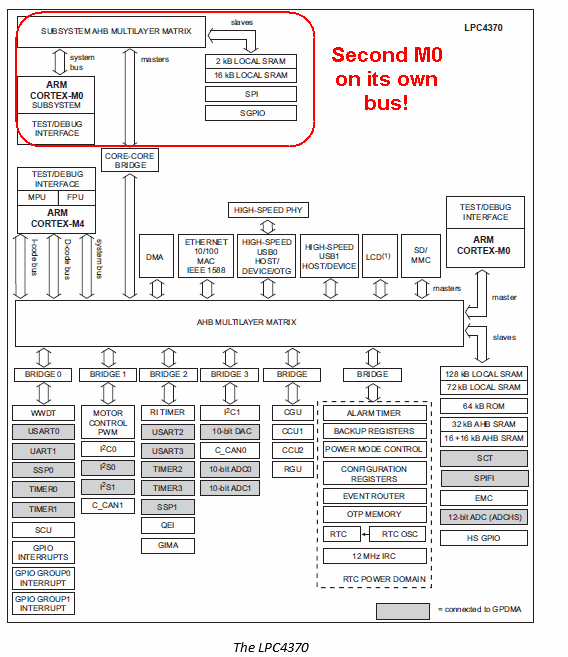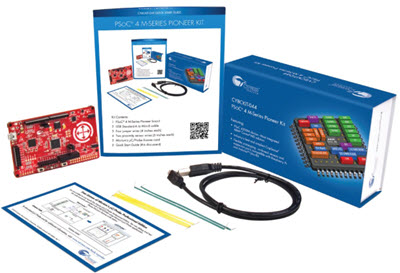
|
For novel ideas about building embedded systems (both hardware and firmware), join the 35,000 engineers who subscribe to The Embedded Muse, a free biweekly newsletter. The Muse has no hype and no vendor PR. Click here to subscribe.
|
The Most Important Milestones in Embedded in 2013
Published on embedded.com December, 2013
2013 was a big year for embedded systems; a lot of products came out that will shape the future of this industry. Here's some that I found interesting.
NXP's LPC4370 microcontroller is the first in what I expect to be many inexpensive MCUs with multiple, and dedicated, cores on board. Though other parts have more than one core the 4370 is a bit different. It has a Cortex-M4 for the heavy lifting, with hardware floating point and SIMD instructions. A Cortex-M0 is there to provide general co-processing, or to take over in a lower-power mode when the M4 is sleeping. Nothing really new here; that's like their 4350. But there's a second M0 dedicated to controlling just the SPI and SGPIO peripherals. Neither general processor needs to be bothered with these devices, and using an M0 means very high speed and generalized access to the I/O. Even better is that the second M0 has its own memory so is running off the main bus. The desktop processor business has been abuzz about multicore for some time, but I think in the MCU world the landscape is shifting to the use of many dedicated small CPUs for I/O control.

Crypto engines have been around for a few years, and have been integrated on a few microcontrollers. With the furor this year over government information vacuum cleaners I think that we will see crypto become much more common -- and start to be actually used in non-banking type applications that have any sort of connectivity. This year Microchip released their PIC32MZ family of 32 bit microcontrollers, many of which have on-board cryptography, which offloads what can be a complex algorithm from the CPU. Many other companies will follow. Perhaps NSA has inadvertently done the semiconductor industry a favor!
Low-power is increasingly important, and vendors are releasing parts with astonishing performance. Touchstone's new TS3300 PMIC (http://touchstonesemi.com/documentations/ts3300-data-sheet) is an example. It can boost an input voltage as low as 0.6 V, and can supply 75 mA with only 1.2 V in. Their TS3310 (http://touchstonesemi.com/documentations/ts3310-data-sheet) requires only 150 nA.
Analog Devices is playing in this field, too. Their ADP172 (http://www.analog.com/en/power-management/linear-regulators/adp172/products/product.html) regulator offers an input voltage down to 1.6 V and has a 50 mV drop out, and under a microamp of shutdown current. Think of the possibilities in systems powered by LiMnO2 batteries. It's available in a 1 mm square four ball WLCSP package. I have a couple and want to do some prototyping, but have no idea how I'll solder to them.
Vendors have been providing tools to measure power consumption and, in some cases, relate it to the code. I've reviewed a number of these, like the REAL Ice Power Monitor from Microchip (http://www.embedded.com/electronics-blogs/break-points/4421728/MPLAB-REAL-ICE-Power-Monitor), Agilent's N2820A current probe (http://www.embedded.com/electronics-blogs/other/4419670/Agilent-s-N2820A-Current-Probe), IAR's I-Jet (http://www.embedded.com/electronics-blogs/break-points/4412061/IAR-s-I-jet-power-debugger), the uCurrent (http://www.embedded.com/electronics-blogs/break-points/4406380/The--Current), and the Real Time Current Monitor (http://www.embedded.com/electronics-blogs/break-points/4410138/Real-Time-Current-Monitor). Now that battery operation is hugely important for so many systems it's clear that these sorts of tools will become very important.
This year Fairchild Semiconductor predicted that there will be a trillion sensors deployed by 2020. Smart phones now have all sorts of strange sensors on-board, like humidity detectors, which are there in the hopes that some bright developer will use them to create a killer app. It's a strange market when a product is sold to the masses without a clear idea why some of the components are on the board. (Madman Muntz made his fortune the opposite way, cutting components out of his TVs until they stopped working.) InvenSense, for instance, sells a lot of motion and sound sensors, including a nine axis (3-axis gyroscope, 3-axis accelerometer and 3-axis compass) device with on on-board motion processor IC that has a simple I2C interface (http://www.invensense.com/mems/gyro/nineaxis.html). The future will see us surrounded by a field of sensors connected to very low power, but quite capable, MCUs.
On the software front, LDRA unbundled their unit testing software. LDRAunit (http://ldra.com/index.php/en/products-a-services/ldra-tool-suite/ldraunit) is available for a price on the par of a decent IDE. It does a basis path analysis of all, or a subset, of the functions in a program and generates all of the unit tests. It will even create MC/DC tests. I have seen a 10KLOC program that required 50KLOC of unit tests. The cost savings from automatically generating the unit tests can be staggering.
One of the coolest things this year, which actually won't be available till mid-2014, is Gabotronics oscilloscope watch (http://www.gabotronics.com/oscilloscopes/oscilloscope-watch.htm). This is, or will be, a two channel scope with 8 logic analyzer inputs and a waveform generator, all worn on the arm. It will do an FFT and has all of the features one has come to expect in a tiny scope. Unlike the current generation of USB instruments that rely on a PC for display and control, the scope-watch has a tiny LCD display! The specs don't say, but it may even tell time.
Nothing will say "geek" like an oscilloscope as a fashion accessory. But, oh, man, I want one of these.


